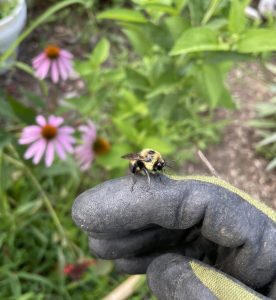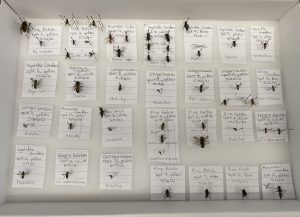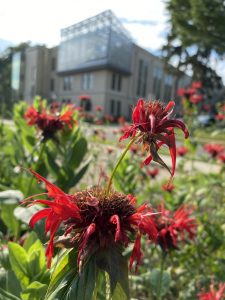What pollinators are in your garden?

[1]
Bees account for a large percentage of insect pollinators. There are estimated to be over 20,000 species of bees, approximately 3,600 of which are native to the United States and Canada. More than 90% of these species lead solitary lives. This means that instead of living in a central colony, each female bee creates her own nest without assistance from others (3). Most solitary bees are not aggressive, and many do not even have stingers, meaning they are undeserving of the fear that many people have towards bees. Bees have a variety of specialized anatomical structures that readily collect and transfer pollen when the bee visits a flower (3).
Butterflies and moths, both members of the order Lepidoptera, are also valuable pollinators found in our gardens. Unfortunately, their populations are declining along with the populations of many other insect species (3).
Flies and beetles are very diverse groups of organisms. Flies are comprised of over 85,000 species worldwide, and beetles account for ¼ of almost all species on Earth combined. These insects often are not credited as pollinators but are common in your garden and are important pollinators for many plants (3).

Bee specimens that have been collected at our pollinator gardens at Wooster. [2]
Why are pollinators so important to your garden?
Pollination is the process of a pollen grain (analogous to a sperm cell) moving from the anther (male part of flower) to the stigma (female part of flower), which then causes the ovary to be fertilized. The ovary is generally what then develops into the fruit.
Pollination is essential to the reproduction of all flowering plants. Some plants have flowers that are adapted to be pollinated by the wind, but many others rely on animals to transfer their pollen. Pollinators are responsible for pollinating 1,200 different crops. Their contributions to the global economy are estimated to be worth over $33 trillion USD annually (4).
Pollinators are critically important to agriculture, the global economy, -and most importantly- the global ecosystem (2,3,4). Pollinators can also be crucial to other aspects of your life on a smaller scale. For example, you may have, or know someone who has, a vegetable garden. Since plants do not produce fruits until their flowers are pollinated, pollinators can affect this as well. Without pollinators, flowers would not be fertilized. This is problematic for both the plant (no fertilization means no seeds, which means no reproduction) and for humans (fruits are often the crop that the plants are grown for).
Why are pollinators in your garden?
Over hundreds of millions of years, plants and pollinators have co-evolved. This has led to the development of strong or mutualistic relationships between plants and pollinators. Mutualistic relationships, or mutualisms, are interactions between multiple species where the interaction is

[3]
In many mutualisms between plants and their pollinators, each have evolved morphological structures that work with the structures of another. For example, bumblebees exhibit a foraging behavior called buzz pollination, in which a bee grasps the flower with its jaws and vibrates its wing muscles to dislodge pollen from the anther (3,5). Buzz pollination is especially common in the Solanaceae family, which includes potatoes, bell and chili peppers, eggplants, tomatoes, and much more.
Based on the morphological characteristics of a flower, we can guess what kind of pollinators it has developed mutualisms with. These characteristics are called Pollinator Syndromes (6).

[4]
There are different pollination syndromes for each type of pollinator. A more complete guide to the characteristics of pollination syndromes can be found here (6). You can compare the flower characteristics in the table to the blooms of your plants to find out what pollinators are likely visiting your garden.
further reading:
Learn more about what is happening to local pollinators: The Problem
Learn how you can support local pollinators: Now what? The things you can do to help
Literature Cited
[1] Landry, C. L. (2010). Mighty Mutualisms: The Nature of Plant-pollinator Interactions. Nature news. Retrieved December 6, 2021, from https://www.nature.com/scitable/knowledge/library/mighty-mutualisms-the-nature-of-plant-pollinator-13235427/.
[2] Pollinator Partnership. (2021). About pollinators. Pollinator.org. Retrieved November 17, 2021, from https://www.pollinator.org/pollinators.
[3] Xerces Society for Invertebrate Conservation. (2021). Who are the pollinators? Retrieved November 17, 2021, from https://www.xerces.org/pollinator-conservation/about-pollinators.
[4] Costanza, R., d’Arge, R., de Groot, R. et al. (1997). The value of the world’s ecosystem services and Natural Capital. Nature, 387(6630), 253–260. https://doi.org/10.1038/387253a0
[5] Bowers, K. A. (1975). The pollination ecology of solanum rostratum (Solanaceae). American Journal of Botany, 62(6), 633–638. https://doi.org/10.2307/2441943
[6] Pollinator Partnership. (2010.). About pollinators. Pollinator.org. Retrieved November 17, 2021, from https://www.pollinator.org/pollinators.
Image Credits
[1,2,3,4] Photos taken by Ashley Arons. 2021.
This page was made by J.S. to increase plant appreciation as part of Wooster’s Field Botany Fall 2021 course.